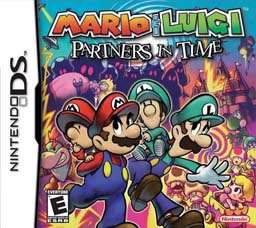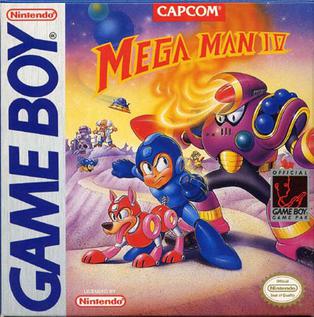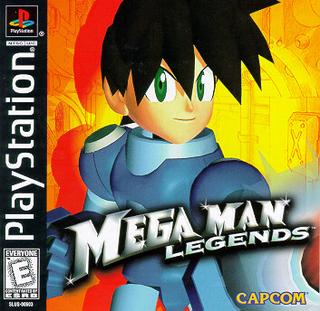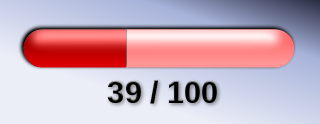
Mario & Luigi: Superstar Saga is a role-playing video game developed by AlphaDream and published by Nintendo for the Game Boy Advance in 2003. The game is the first in the Mario & Luigi RPG series. The game was later re-released for the Wii U Virtual Console on the Nintendo eShop in 2014, and remade for the Nintendo 3DS as Mario & Luigi: Superstar Saga + Bowser's Minions in 2017.

Pokémon Red Version and Pokémon Blue Version are role-playing video games developed by Game Freak and published by Nintendo for the Game Boy. They are the first installments of the Pokémon series. They were first released in Japan in 1996 as Pocket Monsters Red and Pocket Monsters Green, with the special edition Pocket Monsters Blue being released in Japan later that same year. The games were later released as Pokémon Red and Blue in North America and Australia in 1998 and Europe in 1999.

Pokémon FireRed Version and LeafGreen Version are enhanced remakes of the 1996 video games Pokémon Red and Blue. The new titles were developed by Game Freak, published by The Pokémon Company and Nintendo for the Game Boy Advance and have compatibility with the Game Boy Advance Wireless Adapter, which originally came bundled with the games. FireRed and LeafGreen were first released in Japan in January 2004 and released in North America and Europe in September and October respectively. Nearly two years after their original release, Nintendo re-marketed them as Player's Choice titles. The two games hold the distinction of being the first enhanced remakes of previous games within the franchise.

Mega Man X: Command Mission, known in Japan as Rockman X: Command Mission (ロックマンXコマンドミッション), is a video game developed by Capcom for the PlayStation 2 and Nintendo GameCube. The game is the spin-off to the Mega Man X franchise. It was first released in Japan on July 29, 2004, with releases in North America and Europe following that September and November.

Pokémon is a series of video games developed by Game Freak and published by Nintendo and The Pokémon Company as part of the Pokémon media franchise. First released in 1996 in Japan for the Game Boy, the main series of role-playing video games (RPGs), also referred as the "core series" by their developers, has continued on each generation of Nintendo's handhelds.

Robotrek is a role-playing video game released in 1994. It was published by Enix and developed by Quintet and Ancient for the Super Nintendo Entertainment System.

Mario & Luigi: Partners in Time is a role-playing video game developed by AlphaDream and published by Nintendo for the Nintendo DS handheld game console in 2005. It is the second game in the Mario & Luigi series, and is the prequel/sequel to Mario & Luigi: Superstar Saga for the Game Boy Advance. The game was followed by Mario & Luigi: Bowser's Inside Story, released in 2009. The game was later re-released for Wii U as a Virtual Console title in 2015, available for purchase from Nintendo eShop.

Namco × Capcom is a tactical role-playing (RPG) crossover video game developed by Monolith Soft for the PlayStation 2 and published by Namco in 2005. The gameplay combines tactical RPG and action sequences during battles, featuring characters from video game series owned by Namco and Capcom. The narrative sees Reiji Arisu and Xiaomu, operatives for paranormal investigative group Shinra, confront distortions bringing characters from other realities into their own.

Mega Man Battle Network is a video game developed by Capcom for the Game Boy Advance (GBA) handheld console. It is the first title of the Mega Man Battle Network series of games. It was originally released in Japan as a GBA launch game on March 21, 2001 and was released later that year in North America and Europe. It was also released via the Wii U Virtual Console in Japan on July 9, 2014, in Europe on July 24, 2014, and in North America on July 31, 2014.

Mega Man IV is a action-platform video game by Capcom for the Nintendo Game Boy. It is the fourth installment in the handheld version of the Mega Man series. The game continues the quest of the protagonist Mega Man in the struggle with his long-time nemesis Dr. Wily, who sends out a disruptive radio signal to cause a rampage, citywide destruction from dormant robots. Mega Man IV features the traditional action platforming gameplay of the prior games while introducing one new feature, the ability to purchase items with power-ups found throughout each stage. As with previous Game Boy releases, the game incorporates gameplay elements and bosses from two sequential Nintendo Entertainment System (NES) games: Mega Man 4 and Mega Man 5. The game has received a warm critical reception. In 2013, Mega Man IV was made available on the Virtual Console of Japan's Nintendo eShop for the Nintendo 3DS. It was later released in the North American and PAL region eShops the following year.

Mega Man Legends is an action-adventure shooter game released by Capcom. It is the first game in the Mega Man Legends sub-series of Mega Man games from Capcom, and the second major 3D polygonal Mega Man title released in the franchise, following Mega Man: Battle & Chase. It was released on the PlayStation in 1997 in Japan and in 1998 in North America. A Nintendo 64 port was released in 2000 with the same title, but it was renamed Mega Man 64 for the English release in 2001. Another port was released for Microsoft Windows in 2001, and PlayStation Portable in 2005, with the latter only in Japan.

Mega Man 2: The Power Fighters is an arcade video game, released in Japan in 1996 as a fighting game in the Mega Man series of games. It is the direct sequel to Mega Man: The Power Battle released the previous year. Both games were ported to home consoles in North America in 2004 as part of the Mega Man Anniversary Collection for PlayStation 2, Xbox, and GameCube and in Japan during the same year as part of two game compilation titled Rockman: Power Battle Fighters, also for the PlayStation 2. An adaptation of both games for the Neo Geo Pocket Color, titled Rockman Battle & Fighters, was also made.
RPG Maker 3 is the fourth PlayStation version of the RPG Maker series. It is the second game in the series released on the PlayStation 2. The game was also released on the PlayStation 3 on April 16, 2013 through the PlayStation Network.
An overworld is, in a broad sense, an area within a video game that interconnects all its levels or locations. They are mostly common in role-playing games, though this does not exclude other video game genres.

Pokémon: Platinum Version is a role-playing video game developed by Game Freak, published by The Pokémon Company and Nintendo for the Nintendo DS handheld game console. It is an enhanced version of Pokémon Diamond and Pearl and is part of the fourth generation of the Pokémon series of video games. It was released on September 13, 2008, in Japan; March 22, 2009, in North America; May 14, 2009, in Australia and May 22, 2009, in Europe. The developers made Platinum with the intent of making it a stronger version of Diamond and Pearl, which they described as the "ultimate" Pokémon titles.

Metal Gear Solid: Peace Walker is an action-adventure stealth video game developed by Kojima Productions and published by Konami for the PlayStation Portable (PSP) in 2010. It is the seventh Metal Gear game written, directed, and designed by Hideo Kojima, as well as the second action-based Metal Gear title made specifically for the PSP, following Metal Gear Solid: Portable Ops; it was later released for the PlayStation 3 and Xbox 360 as part of the Metal Gear Solid HD Collection in North America and Europe and as a stand-alone retail release in Japan. This is the first title in the series to alter the traditional tagline "Tactical Espionage Action" to "Tactical Espionage Operations", referring to the base building and mission mechanics of the game.
Eastern role-playing video games (RPGs) are RPGs developed in East Asia. Most Eastern RPGs are Japanese role-playing video games (JRPGs), developed in Japan. RPGs are also developed in South Korea and in China.

Pocket Mortys, also known as Rick and Morty: Pocket Mortys, is a free-to-play Rick and Morty-themed role-playing video game developed by Big Pixel Studios and published by Adult Swim Games. The game was released worldwide on 13 January 2016 for iOS and Android devices. The game is set in the Rick and Morty "Rickstaverse" and the mechanics serve as a parody on the Pokémon franchise.

Pokémon: Let's Go, Pikachu! and Pokémon: Let's Go, Eevee! are role-playing video games developed by Game Freak and published by The Pokémon Company and Nintendo for the Nintendo Switch. The games are the first main series Pokémon entries for the system, and the first main titles to be released on a home console. They are enhanced remakes of the 1996 video games Pokémon Red and Blue, and the 1998 video game Pokémon Yellow. The games also feature integration with the mobile game Pokémon Go and support a new optional controller, the Poké Ball Plus.























